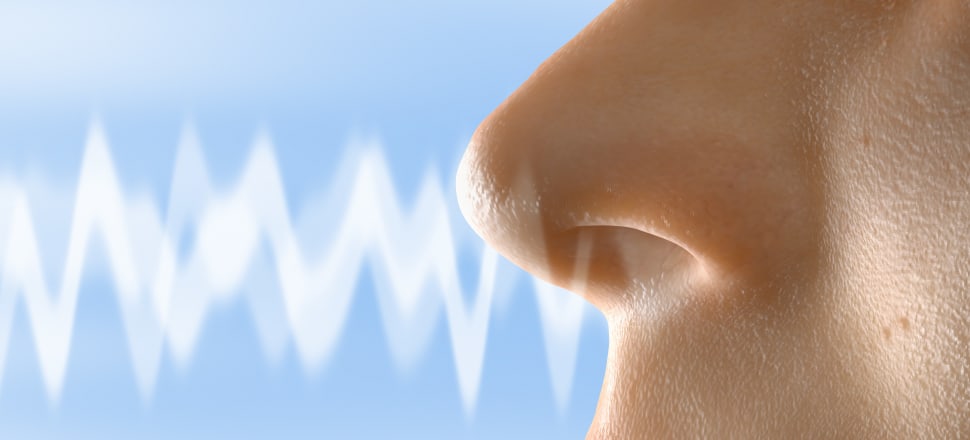The nose and sense of smell provide early indicators of Covid-19 and neurodegenerative diseases, and could be important in determining the cause of diseases, writes Professor Maurice Curtis of the University of Auckland.
Have you ever experienced a momentary smell that instantly took you back to a specific event, as if it were happening again? The smell of sunblock reminding you of summer on a beach; the scent of a flower transporting you back to a Pacific Island getaway.
The human sense of smell is remarkable, allowing us to detect and remember millions of odours and linking that odour with events in our lives.
Humans use their sense of smell to, for example, identify ‘off’ food, turn away from malodorous substances, heighten alertness and subconsciously influence our partner selection; indeed the sense of smell goes part way to explaining attraction. From a daily living perspective a good sense of smell improves our quality of life. In studies of those who have lost their sense of smell, a condition called anosmia, 70 percent of people report reduced quality of life while nearly 60 percent felt it altered their daily living.
One of the most common situations where we see anosmia is in the early stages of neurodegenerative diseases such as Alzheimer’s and Parkinson’s disease in which 90 percent of cases are pre-empted by two to four years of anosmia before the motor or cognitive symptoms are apparent. But nasal infections are also common causes of anosmia and, it seems, Covid-19.
From a biological perspective the sense of smell (olfaction) is fascinating, because the brain cells (neurons) that detect chemicals that form odours (odorants) are the only neurons directly exposed to the outside world. If the eyes are the window into the soul then the nose is the window into the brain. When we breathe in, we are directly exposing brain cells in the nose to the contents of the air we breathe.
These brain cells (the olfactory neurons) sit in the roof of the nose and have odour detectors (or receptors) that respond when a chemical odorant in the air binds to that receptor. Each breath of air exposes millions of neurons to hundreds of odorants that activate a different combination of a possible 400 receptors leading to millions of possible combinations of receptors being activated.
If the air contains pollutants, bacteria or viruses such as coronavirus or any other pathogen then we are also exposing the brain directly to those substances through the olfactory neurons in the nose. We know for example that viruses that cause rabies, polio and influenza (and others) can enter the brain through the nose and so too can SARS-Cov2, the virus that causes Covid-19.
One of the factors that seems to be causing the rampant spread of Covid-19 is the long ‘prodromal’ period. This is the initial stage of a virus when ‘no serious symptoms’ are evident and when spread of the virus is commonplace. Indeed, super-spreaders may be young people who have no significant symptoms so do not seek medical help but may spread the virus to those at high risk.
One of the symptoms that fits within the ‘no serious symptoms’ category is anosmia, which precedes pulmonary symptoms and is present in a high proportion of those who only experience mild Covid-19 symptoms. In a recent multicentre study in Europe involving 12 hospitals and 417 mild-moderate Covid-19 patients, 86 percent had anosmia. Even among the people with no nasal obstruction or rhinitis (a stuffy or runny nose) 79 percent had anosmia. But why?
The virus that causes Covid-19 enters the body through olfactory cells in the nose and in the lungs that have a particular receptor; the lungs and nose have the highest abundance of these receptors in the body as far as we know currently. In this regard, and in relation to neurodegenerative disease, the olfactory system is a sentinel, a canary in the mine telling us the most exposed neurons in the body are under attack. The nose is telling us that a nasal infection, or Alzheimer’s or Parkinson’s is beginning its incipient spread into the body or brain.
With such an important environmental sensor situated literally right in front of us (i.e. your nose) it would make sense to utilise the information it is telling us as much as possible.
Certainly the opportunity to identify early Covid-19 infection, or to determine the consequences of nasal infections, or to track back in people with neurological diseases to see what events occurred when they lost their sense of smell, may be a way to pinpoint triggers for development of the disease.
Alternatively, early detection of anosmia or hyposmia (the partial loss of the sense of smell) and monitoring for any improvement may be helpful in determining if treatment is effective early on in a disease process. In the work we are doing on neurodegenerative diseases such as Parkinson’s disease and frontotemporal dementia we are incorporating these concepts into everyday research.
There is much more work to do to understand the development and origin of many diseases. However, it is clear that the nose is an important structure to research, not only to understand the scientific and medical challenges of brain diseases such as Parkinson’s disease, but also to understand and develop treatments for global pandemic diseases in which the olfactory system is affected.













